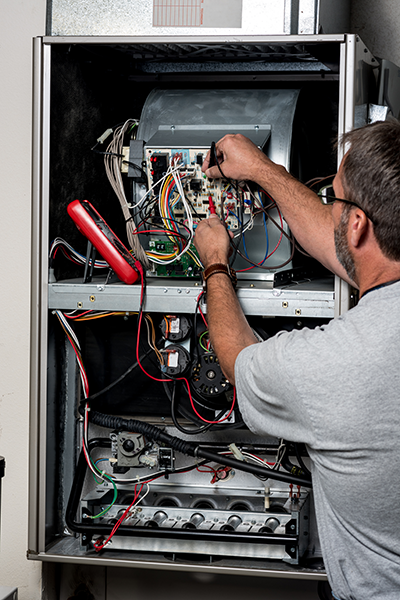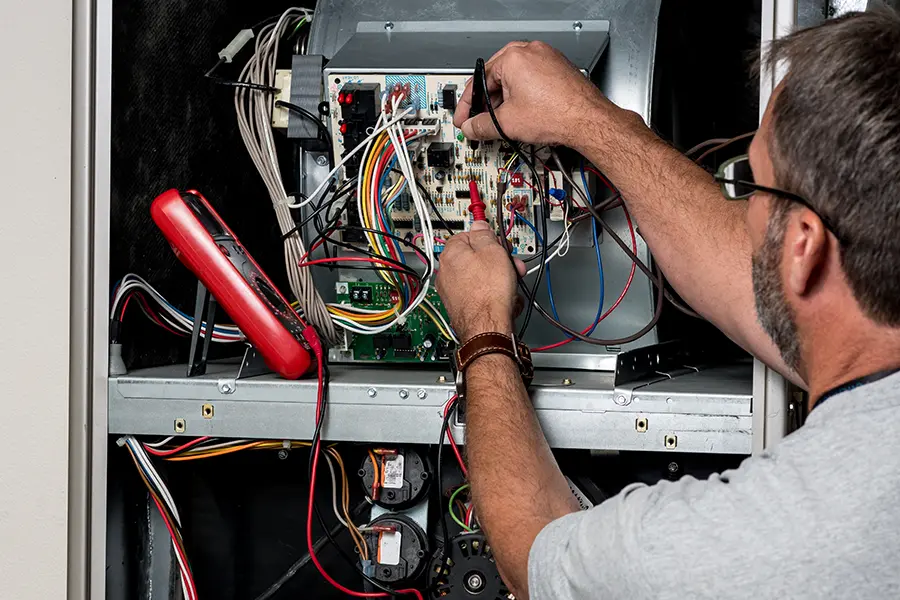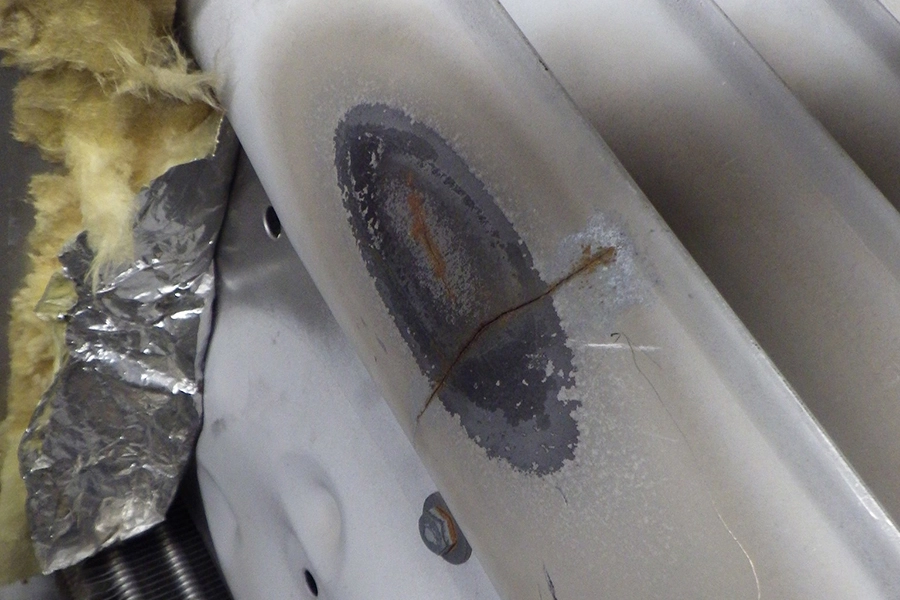If you’re a handy homeowner or just someone who wants to try to save some money by fixing their furnace themselves, then you’ll need to know what the lights on your furnace mean. Knowing what the light means is the first step to diagnosing the problem.
Where do I find the lights on my furnace?
Most of the time, your furnace will have a small clear piece of plastic in one of the doors. If you look through this hole, you should see a circuit board with a light flashing. It may be red, green, amber, or a combination.
If your furnace does not have a plastic sight hole in the door and is an older model, it may not have a way to view a diagnostic code. However, there was a time when instead of a circuit board, the units were equipped with a “smart valve.” This is a gas valve that acts like a circuit board. You may want to check the valve if you do not have a diagnostic code anywhere else.
What do the lights mean on my furnace?
You will typically see a red, green, or amber light on your control board. Sometimes they will blink, and sometimes they will be steady. Whether they are steady on, flashing, or how many times they flash, will indicate different issues.
Service technicians and homeowners can look up the diagnostic codes for their specific furnace to get an idea of what could be wrong. Having this feature means that a service technician will be able to solve the problem much quicker than they could have in the past.

How to read a furnace error code?
Depending on what the light represents, it’s sometimes as easy as just seeing if the light is on. If the light is steady on, that may mean that your furnace is working just like it is supposed to. Sometimes it’s slow flashing, similar to a “heartbeat,” which usually means it’s working correctly.
If the light flashes quickly or has a long space after a certain number of flashes, you can assume it is giving you a code. Sometimes a “rapid flash” is the code reference, but usually, you will have to count the flashes.
Your diagnostic codes will sometimes consist of two numbers, so you will have to count the flashes twice in those cases. When you count the flashes, they are all the same speed but will have spaces between a certain amount of them. You will want to grab a piece of paper and count the first set of flashes, from when they start after the long pause until they end at the next break. Write that number down. Once the next pause is over, count the flashes until the long pause, and you will have your fault code.
How can I find out what the lights mean?
The code definitions can usually be found on the inside of one of the covers on the front of the furnace. If you look at the inside, it will have a chart that tells you the light colors, if different colors are applicable, and then a row of numbers with the coinciding diagnosis beside each one.
Warning: Before removing the cover to look for the meaning of the code, make sure that you have the code number written down.
Furnaces are likely equipped with a door switch, which means that when you take the door off to access the circuit board, it will shut the main power off. If that happens, you will not be able to access the code anymore unless the board can recall it, you know how to recall it, or if it was to fault out as soon as it got turned on and gave you the exact code once again.
Suppose you do not have the codes inside your furnace door, then you can find them in the manual if you still have it. And if you do not have the manual anymore, then you should be able to find it with a quick search online. Type in the model number as shown on your unit and then “service manual.” The data tag that contains the model number will usually be placed on the inside of the furnace, on the side by the burner assembly. Or right below the burner assembly. You can attempt to look up the diagnostics by themselves but finding the service manual seems much simpler.
How do you reset the light/furnace?
To reset the furnace, you will need to turn the main power supply off to the furnace and wait a few seconds before turning it on. If the door switch is operational on your furnace and you have had the door off looking for the code, it has already reset. If for some reason, your door switch is no longer operational or your furnace does not have one, then you will need to shut the power off another way.
If your thermostat does not reset when you shut the power off to your furnace, which most smart thermostats and battery-backed thermostats will not, then it will presumably be in heat when the power is turned back on. If the heat is on when the unit is powered back up, almost every furnace will go into a default fan mode. Your blower fan will run for ninety seconds while it gives you a code telling you this. So, don’t be alarmed as this is a regular occurrence.
Common Faults
- Open limit or open high limit: This is generally caused by a dirty filter. Your limit switches are designed to shut your unit off if it gets too hot. If your filter is dirty, your unit can’t cool itself down from blowing the air from your house through it, and it gets too hot.
- No light: You have lost the primary or 24V communicating voltage. You could have a breaker that has tripped, which turned off the power. Or your thermostat wires are grounded. This is most commonly caused by something damaging the thermostat wires by your outdoor units, such as a weed eater or animal. It is also common after homeowners change their own thermostats without shutting the power off first.
- No flame sensed: This likely means that your flame sensor is dirty. It will need to be replaced.
- Failure to ignite: The hot surface igniter that lights the gas is no longer working and will need to be replaced.
- Pressure switch failed to close: This can be caused by several things. The inducer fan isn’t running, the inducer fan blades are missing, or the pressure switch is bad.
Links to the standard furnace code charts
Trane Fault Codes
The fault codes will be structured in this way:
Code
Error
Solution
Clarification (if applicable)
Trane Fault Codes:
Flashing slow
Normal, no call for heat
This is only a problem if your thermostat is calling for heat
Flashing fast
Normal, call for heat
This is only a problem if your thermostat is not calling for heat
Continuous on
Control panel issue
Replace the control panel
The control panel will be the circuit board
Continuous off
No power
Check for power
2 Flashes
External lockout, the number of retries exceeded
Check for miswiring, clogged pilot tube, or humidity in the unit
This means that the unit has tried to light and failed too many times. It will have to be reset before it will try again.
3 Flashes
Pressure switch issue
Check if the drain tubes are obstructed with dirt or full of moisture.
4 flashes
Open high limit device
The issue with thermal protection
Your unit got too hot, which could be from a dirty air filter
5 flashes
Flame sensed when NO flame should be present
Check for a leaky gas valve, stuck gas valve, or defective flame sensor
6 flashes
115 VAC power reversed polarity or poor grounding
Correct line voltage polarity and check wiring.
Your two power wires are connected to the opposite wires in the unit.
7 flashes
Gas valve circuit error
Check your unit’s gas valves for the issue
Something has caused your gas valve to lose the proper voltage
8 flashes
Flame sense signal
Check flame sensor malfunction or low gas pressure.
9 flashes
Check igniter
Check igniter
This will be the hot surface igniter that lights the fuel in your furnace.
American Standard Fault Codes.
American Standard owns Trane, so multiples of their codes will be similar.
The fault codes will be structured in this way:
Code
Error
Solution
Clarification (if applicable)
American Standard Fault Codes:
2 flashes
Dropped flame signal
Check flame sensor
3 flashes
Pressure switch failure
Check the operation of the pressure switch
4 flashes
Indicates a problem with the limit switch
The furnace has gotten too hot, will need to check for proper airflow
A dirty filter can cause this
6 flashes
115 VACS has reversed polarity
Reverse the polarity of the power
The two wires that make up the main power need to be hooked to the opposite two wires in the unit
7 flashes
Gas valve circuit error
Check the gas valve
The gas valve is not getting the correct voltage
9 flashes
The igniter is not working
Check the igniter
22 flashes
Flame issue
Check to make sure the flames are burning like they are supposed to. A weak burning flame may cause this.
Carrier Fault Codes.
The dashes between the codes for Carrier will represent a space. For example, the 1-1 would mean that the LED would flash once, short pause, then flash again, and then end with a long delay.
The fault codes will be structured in this way:
Code
-Error
-Solution
-Clarification (if applicable)
Carrier fault codes:
Rapid flashing
-Polarity reversed
-Switch the power wires coming into the opposite wires
1-1
-No code
-The previous codes have been erased, and there is no code stored.
1-2
-Blower on after startup
-This is a 90-second occurrence when the unit is powered up while the thermostat is calling for heat
1-3
-Flame or limit rollout lockout
-The unit has gotten too hot, or the flames have backfired out of the burner chamber. It will reset after 3 hours.
1-4
-Ignition lockout
-Control will reset after 3 hours
-The unit tried to light too many times, so it is locking itself out for 3 hours to prevent damage
2-1
-Gas heating lockout
-Control will not auto-reset, check for bad gas valve or wiring
2-2
-Abnormal flame proving signal
-Flame is sensed when the gas valve should be closed. Check for leaking or stuck open gas valve.
2-3
-The pressure switch did not open
-Check for an obstruction in the pressure switch tubing that could restrict airflow
2-4
-The secondary voltage fuse is open
-Check for a short circuit in the 24V wiring.
-Thermostat wires are touching a grounding point somewhere in the circuit.
3-1
-Pressure, draft safeguard, aux-limit switch, or blocked vent switch didn’t close (or reopened, downflow only)
-If open for longer than 5 minutes, the inducer will shut off 15 minutes before retrying. Check for:
Low inducer voltage.
Proper vent sizing.
Defective inducer motor.
Faulty blower motor or capacitor.
Bad pressure switch.
Restricted vent.
Excessive wind, inadequate combustion air supply.
Obstructed pressure tubing.
-This means that the inducer fan that pulls the combustion gases through the furnace and into the vent is not creating enough pressure to do its job.
3-3
-Limit or flame rollout open
-If the switch is open for longer than 3 minutes, the code will change to #1-3. The flame rollout switch requires a manual reset. Check for: defective blower motor or capacitor; dirty filter or restricted duct system; loose blower wheel; faulty switch or connections; or inadequate combustion air supply.
-This means either the unit got too hot, or the flame came out of the burner assembly.
3-4
-Ignition proving failure
-Control will try three more times before lockout #1-4 will occur. If the flame signal is lost after the trial for the ignition period, the blower will come on for a 90-second recycle delay. Check for: build-up on the flame sensor; proper microamp distribution to the flame sensor; defective gas valve or turned off gas valve; faulty hot surface ignitor; low inlet gas pressure; the manual valve is shut off.
-This means that the unit lit like it was supposed to, and the flame sensor never acknowledged that the flame was there.
Lennox Fault Codes
These will be read in the same manner as the carrier fault codes: a set of flashes, a short pause, a set of flashes, and then a long pause. After which, it will start over.
The fault codes will be structured in this way:
Code
Error
Solution
Clarification (if applicable)
Lennox Fault Codes:
Pulse
Power on-standby
Heartbeat
Normal operation with call for heat from the thermostat
1 + 2
Low flame current
Flame is weak
1 + 3
Flame sensed out of sequence
Check the gas valve
Flame is present when the gas valve should be off.
2 + 3
The low-pressure switch failed to open
Check for proper inducer fan operation.
Your inducer fan will push the air out of your exhaust, and its suction is what opens the pressure switch.
2 + 4
The low-pressure switch failed to close
Check for faulty pressure switch or continuously running inducer fan
2 + 5
The high-pressure switch failed to open
Check for proper inducer fan operation
2 + 6
The high-pressure switch failed to close
Check for faulty pressure switch or continuously running inducer fan
2 + 7
The low-pressure switch opened during ignition trial or heating demand
Check for proper pressure switch operation
3 + 1
Limit switch open
Your furnace has gotten too hot, which can be caused by a dirty air filter
4 + 1
Exceeded the number of retries
The furnace has shut itself down because it failed to light. It will need to be reset.
4 + 2
It exceeded the number of retries. The last retry failed due to the pressure switch opening.
Check for proper pressure switch operation.
4 + 3
Exceeded number of retries. The last retry failed due to flame failure
Ensure that the gas valve and igniter are working properly
4 + 5
Limit switch remained open for longer than 3 minutes
The furnace got too hot for too long. It could be a dirty filter or a cracked heat exchanger.
4 + 6
Flame sensed out of sequence; flame gone
Check for faulty or stuck open gas valve
4 + 7
Ignitor circuit fault
Ignitor has failed
4 + 8
Low line voltage
Check the main voltage coming into the unit
5 + 1
Hard lockout
Rollout circuit open or previously open
The flames came out of the burner assembly, so the unit shut down for safety
5 + 2
Control failed a self-check
The Circuit board found a fault within itself and shut down. We will restart if the issue is resolved.
5 + 3
No ground
Reconnect the ground
5 + 4
Reversed line voltage
Switch the two main voltage wires coming into the two opposite wires they connect to
5 + 6
Low secondary voltage
Check the transformer and 24V fuse
Amana Fault Codes
Amana and Goodman are owned by Daikin Industries, so that they will have the same fault codes.
The fault codes will be structured in this way:
Code Number
Error
Solution
Clarification (if applicable)
Amana Fault Codes:
Continuous on
No thermostat signals
Check all the thermostat connections
1
Ignition lockout due to excessive retries
Check the igniter and gas valve for proper operation.
2
The draft inducer is not operating, or the pressure switch has closed
Ensure that the inducer motor is operating correctly
3
The pressure switch is open
The pressure switch may need to be replaced
4
Pressure issue. High limit cut-off due to faulty wiring or bad filters
Replace or clean the air filter, clean drain tubes, and check limit switches.
The furnace got too hot and shut itself off.
5
The unit is sensing flame without a call for heat
It could be a stuck open or faulty valve
7
Faulty flame sensor
The flame sensor is dirty or faulty. Clean if dirty, replace if faulty
Continuous flashing
The polarity of volt power is reversed
Switch the main power wires to the opposite wires they connect to.




